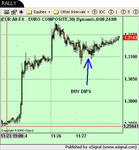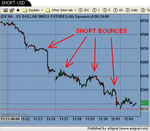Everyone loves the Dollar…
Trading Commentary for Thursday, October 12, 2006.
The USD gained ground today in all major currency pairs. A slight pullback in the early US session allowed for a tremendous buying opportunity as the USD expanded its rally following the FOMC minutes release at 2:00 PM (EST). Forecasting this move early simply required the understanding of supply and demand. Recently, there have been more buyers of the USD than sellers… when the absence of buyers occurred, no sellers showed up. Common sense tells you that even if no one is getting short, there will be some profit taking after this huge uptrend. But, the buyers stood their ground (and on low volume) and the sellers never showed. From an objective standpoint, the buyers far outweighed any sellers, and it was time to get on board.
Critical point for Thursday: Can the EUR/USD break the 1.2500 level? This would be the last straw holding the USD back from putting in its best rally of the year. Contrarians will try to buy the majors against the USD as long as this level is held, but its going to take a lot more than bottom pickers to stop the USD. Relatively speaking, if the EUR/USD can stay below 1.2500, going long the USD in any major pair is a must.
Theoretically speaking, it would be bullish for the USD to have a small pullback and consolidate for a couple of days. This is known as “digesting the move.” Simply put, eventually the long speculators become less excited about the new prices they are getting and start laying off the buys. Then the long profit taking occurs (presence of sellers). If the sellers can not press the USD down hard, then we know the simple economics state that the buyers are still there… they just want better prices… for now. Always buy the pullbacks in an uptrend until it proves you wrong, it keeps your risk vs. reward working for you.
Below are the charts of 4 major pairs. You will see the key points compromised in all pairs but the EUR/USD. No matter what currency you are pairing against the USD… watch the EUR/USD tomorrow… and look for pullbacks over the next few days for buying opportunities.
Good luck!
Trading Commentary for Thursday, October 12, 2006.
The USD gained ground today in all major currency pairs. A slight pullback in the early US session allowed for a tremendous buying opportunity as the USD expanded its rally following the FOMC minutes release at 2:00 PM (EST). Forecasting this move early simply required the understanding of supply and demand. Recently, there have been more buyers of the USD than sellers… when the absence of buyers occurred, no sellers showed up. Common sense tells you that even if no one is getting short, there will be some profit taking after this huge uptrend. But, the buyers stood their ground (and on low volume) and the sellers never showed. From an objective standpoint, the buyers far outweighed any sellers, and it was time to get on board.
Critical point for Thursday: Can the EUR/USD break the 1.2500 level? This would be the last straw holding the USD back from putting in its best rally of the year. Contrarians will try to buy the majors against the USD as long as this level is held, but its going to take a lot more than bottom pickers to stop the USD. Relatively speaking, if the EUR/USD can stay below 1.2500, going long the USD in any major pair is a must.
Theoretically speaking, it would be bullish for the USD to have a small pullback and consolidate for a couple of days. This is known as “digesting the move.” Simply put, eventually the long speculators become less excited about the new prices they are getting and start laying off the buys. Then the long profit taking occurs (presence of sellers). If the sellers can not press the USD down hard, then we know the simple economics state that the buyers are still there… they just want better prices… for now. Always buy the pullbacks in an uptrend until it proves you wrong, it keeps your risk vs. reward working for you.
Below are the charts of 4 major pairs. You will see the key points compromised in all pairs but the EUR/USD. No matter what currency you are pairing against the USD… watch the EUR/USD tomorrow… and look for pullbacks over the next few days for buying opportunities.
Good luck!




